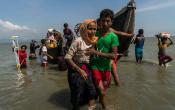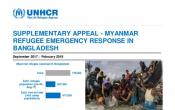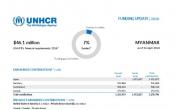Myanmar
Operation: Myanmar
Location
{"longitude":96,"latitude":22,"zoom_level":0,"iso_codes":"'MMR'"}
By clicking on the icons on the map, additional information is displayed.
Key Figures
| 2017 year-end results | |
| 208,300 | IDPs benefitted from camp coordination camp management services focusing on ensuring equitable access to humanitarian services and protection |
| 23,300 | households received core-relief items in Rakhine, Kachin and northern Shan States |
| 16,570 | IDPs received shelter support |
| 2,600 | people with specific needs received special assistance |
| 2018 planning figures | |
| 233,000 | IDPs will benefit from camp coordination and camp management support in Rakhine, Kachin and northern Shan States |
| 6,500 | vulnerable households will receive shelter support in Rakhine, Kachin and northern Shan States |
| 1,000 | protection monitoring visits will be conducted in Rakhine, Kachin and northern Shan States |
| 7,500 | IDP and refugee returnees will be assisted with civil status registration or documentation in south-east Myanmar |
Latest Updates and Related Links
September 2017 – February 2018
People of Concern
8%
Decrease in
2016
2016
| 2016 | 1,302,375 |
| 2015 | 1,414,357 |
| 2014 | 1,186,501 |

[["IDPs",375016],["Returned IDPs",1346],["Returned refugees",74],["Stateless",925939]]
Loading ...
Myanmar
< Back
2017
{"categories":[2013,2014,2015,2016,2017,2018],"budget":[68.48157023,68.10870324,72.77272012,56.212578921,49.16219959,46.11656044],"expenditure":[29.29272236,21.52521921,17.61568966,17.12864861,17.53716726,null]}
{"categories":[2013,2014,2015,2016,2017,2018],"p1":[13.203885,6.09529354,25.313692,28.97865689,17.78248897,9.7805165],"p2":[12.06478301,12.94029106,15.99808438,2.59311248,7.70424298,24.80137031],"p3":[null,null,null,null,null,null],"p4":[43.21290222,49.07311864,31.46094374,24.640809551,23.67546764,11.53467363]}
{"categories":[2013,2014,2015,2016,2017,2018],"p1":[null,null,5.55763533,3.75516825,3.82923806,null],"p2":[5.07377229,5.66947559,3.86446935,2.2372177,3.17102851,null],"p3":[null,null,null,null,null,null],"p4":[24.21895007,15.85574362,8.19358498,11.13626266,10.53690069,null]}
Loading ...
CHOOSE A YEAR
- 2014
- 2015
- 2016
- 2017
- 2018
Operational context
The year 2017 was marked by limited progress of the peace process, an escalation of conflict in Kachin and Shan States and an unprecedented crisis in Rakhine State. This resulted in dramatic setbacks in the protection environment for UNHCR’s people of concern in Myanmar, significant humanitarian needs and limited prospects for durable solutions.The situation in Rakhine State deteriorated dramatically on 25 August 2017, the day after the release of the Rakhine Advisory Commission (RAC) recommendations, when militants launched coordinated attacks on Myanmar security posts in the northern part of the State. Subsequent outbreak of violence in the Maungdaw area resulted in over 655,000 people fleeing across the border into Bangladesh; many more have also been displaced within Rakhine State.
The Governments of Bangladesh and Myanmar bilaterally agreed to an Arrangement On Return Of Displaced Persons from Rakhine State on 23 November 2017, making reference to international standards, notably safe, dignified, and voluntary return; the commitment to working for ‘a comprehensive and durable solution’; and to commencing a process to address root causes in line with RAC recommendations. While UNHCR was neither a party to nor consulted on this agreement, it is considered as playing a key role in assessing the voluntariness of potential returnees and assisting in any actual repatriation.
Population trends
The total estimated population of concern to UNHCR in Myanmar stood at some 849,731 at year-end. The significant decrease in the estimated number of people of concern to UNHCR in Myanmar is solely the result of the outflow of refugees– the vast majority of whom are stateless persons from Rakhine - from Myanmar into Bangladesh.Key achievements
- In south-east Myanmar, UNHCR supported the provision of counselling on civil documentation, information on Housing Land and Property, community-based livelihoods, as well as return and benchmark assessments.
- For the two IDP situations in Rakhine and Kachin / northern Shan States, UNHCR upheld its responsibilities within the inter-agency humanitarian response and assumed both coordination and operational delivery roles in the areas of protection, shelter, non-food items and camp coordination and camp management (CCCM) and delivered services both directly and through partners. UNHCR supported CCCM activities in 150 camps in Kachin, northern Shan and Rakhine States. Some 16,570 displaced people in Myanmar benefitted from UNHCR’s support in shelter construction, maintenance and renovation.
- For the stateless population in Rakhine, UNHCR continued its protection monitoring to inform advocacy – directly when the situation so allowed and remotely when it did not - and the provision of humanitarian assistance. UNHCR distributed core-relief items to stateless households affected by post-9 October 2016 crisis, and families impacted by cyclone Mora, which hit coastal regions of Rakhine on 30 May 2017.
Unmet needs
One of the key protection and assistance gaps faced by UNHCR’s people of concern in Myanmar as a result of limited funding is shelter rehabilitation and repairs in IDP camps. Shelter gaps in Rakhine and Kachin/northern Shan are estimated as 23 per cent with over 53,000 IDPs living in shelters in need of repair or construction.UNHCR also faced limitations with access and in reaching out to all areas for protection monitoring and assistance to persons with specific needs. The frequency of visits and scope of assistance to people with specific needs - especially for the elderly - could not be increased within the level of available resources.
Working environment
Myanmar will continue to be characterized by a combination of statelessness and protracted internal displacement, while being the country of origin for the majority of refugees in the South-East Asia region.Myanmar has recently experienced significant changes in its political landscape with the conclusion of the nationwide ceasefire agreement (NCA) in October 2015 and the formation of a new government led by the National League for Democracy (NLD) in April 2016. With political dialogue and the peace process being the first priorities for the new Government, it is anticipated that these developments will offer new opportunities for UNHCR to engage the Government on durable solutions for internally displaced people (IDPs) and refugees from Myanmar in Thailand, as well as to advocate improved rights for the stateless population. Nonetheless, restrictions on the freedom of movement of the stateless population and IDPs in Rakhine, as well as sporadic armed clashes in the north-eastern part of the country, are likely to continue.
Key priorities
In 2017 UNHCR will focus on:• building the capacity of and providing technical support to the Government to address statelessness in Rakhine and elsewhere in the country;
• monitoring the protection environment to support evidence-based advocacy interventions to address the main protection risks faced by UNHCR’s persons of concerns throughout Myanmar;
• supporting the Government in identifying and implementing durable solutions in Rakhine State, Kachin State and northern Shan State and in facilitating reintegration of refugee returnees in south-east Myanmar;
• responding to humanitarian needs in IDP camps through the provision of shelter, non-food item and camp management and coordination services as well as through protection interventions; and
• leadership of the protection sector and the combined leadership of Shelter/NFI and Camp Coordination and Camp Management clusters.


